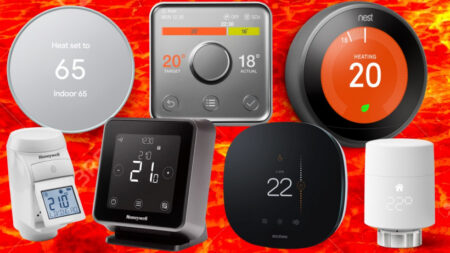Push the button and make your smart home work for you
Smart home buttons are a big thing now. You may think that, as we move away from remote controls, switches and apps and towards a voice-controlled smart home, you’d have no need for another physical controller in your house.
However, the brilliance of the best smart home buttons lie in their simplicity, and multi-functionality from a single press.
Sure, you can turn your bedroom light on with the switch on the wall like your grandpa used to – but can that switch also turn off any lights you may have left on downstairs, turn on all of your security cameras, set your alarm and tune into some sleeping sounds on your smart speaker? It cannot.
Unless it’s a smart light switch, of course, but that’s a different story.
That’s where the current crop of smart buttons come in. With a simple tap, double tap or long press (or maybe a twist) you can trigger an array of smart home scenes and automations.
Sure, you could ask Alexa or the Google Assistant to kick start these routines and control your smart devices, but sometimes it’s so much easier to just push a button – especially as you can strategically place them (and move them) around the house to where they will be most useful.
Plus, a lot of smart buttons – including the likes of Hue and Flic – can even act as triggers for routines and automations within your chosen smart home ecosystem nowadays anyway.
Read on to find out more…
Smart buttons: What to consider before buying
Smart buttons are still a fairly new idea and the market isn’t exactly bursting at the seams with options. However, even if more contenders do come to the party, they won’t really do much more than the current offering can.
Once you go beyond a button that offers two to three scenes at the tap of a button, you’re entering the realm of a remote control, and that would be missing the point. What you do need to consider, though, is what smart home devices and platforms the smart button you’re thinking of buying taps (see what I did there?) into.
Does it support HomeKit scenes, are IFTTT applets compatible? Will it integrate with how you already run your smart home? Will it provide a key control for your most important smart device?
We detailed some of those factors in each entry below, and more information can be sought out from each manufacturer. We’ve lived with the above examples for a while now, and they just work.
You’ll hardly ever have a click (or double, or triple, or long press) go unnoticed and, on the odd occasion this does happen, no button below is more guilty than any other of this misbehavior – we found them to be pretty much on a par when it came to reliability.
The best smart buttons 2023
Here are our picks for the best smart buttons you can use in your smart home, whether you’re trying to control a single appliance, or you’re looking to set up more involved routines and systems.
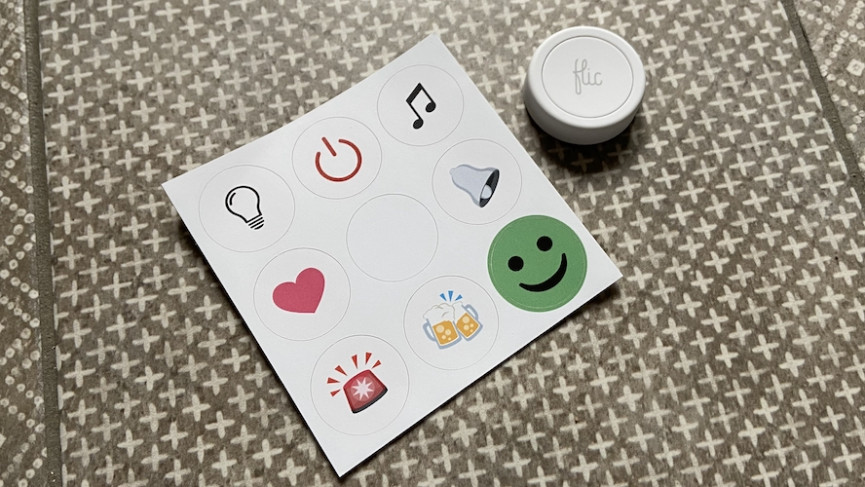
Best overall smart home button: Flic 2
Buy now: Amazon | From $29.99 / £29.99
Flic has been in the smart button game longer than most – it first went live on Indiegogo in 2014, smashing its $80,000 target and raising almost $1 million. The Flic 2, which also began life as a crowdfunding campaign, is easily the most button-like smart button, weighing less than 10g.
The first-gen Flic system was great and the sequel is even better. The range of tech it’s compatible with is huge – highlights include Hue, Lifx, Sonos, Ecobee, Ikea Trådfri, WeMo and Wink – and the gaps can be filled with IFTTT and Logitech Harmony controls and recipes as well. Like the (now discontinued) Logitech Pop, it’s a simple one, two or long tap control method.
Flic allows you, pretty easily, to program routines and actions as simple or as complicated as you require. The hard bit if remembering exactly what each press of each button does.
The app is also jam-packed with ‘fun’ (i.e. naff games) and extras; the most useful being the ‘find my phone’ function that plays a loud alarm through the Flic app on your smartphone. It’s also compatible with a number of fitness platforms – you can start and stop a Strava run with it, for example. It even comes with a little belt clip so you can wear it out and about.
It’s much cheaper than some of its rivals as you don’t need to fork out for a hub – it can work by just using your phone as its gateway.
Now, that has its flaws, of course – you need to allow the app to run at all times and it’ll only work if it’s in Bluetooth-range of your phone – and that’s why Flic offers a hub to pair up to the Flic buttons (from $100 / £100).
The Flic smart home button also has a massive weapon in its arsenal: it can act as a trigger for Alexa Routines.
You could create a morning routine that, after a click on Flic button, reads the news from an Echo Show, tells you what’s in your schedule, turns the smart security alarm off, and switches on a smart plug in the kitchen to get the coffee maker fired up.
Flic users now also have the option of the Flic Twist, which adds some extra controls to the Flic mix.
What we love
- Compact design
- Alexa Routine trigger
- Works without a hub
- Fun extras aplenty
What we don’t love
- App can be a bit flakey
- Hub costs extra
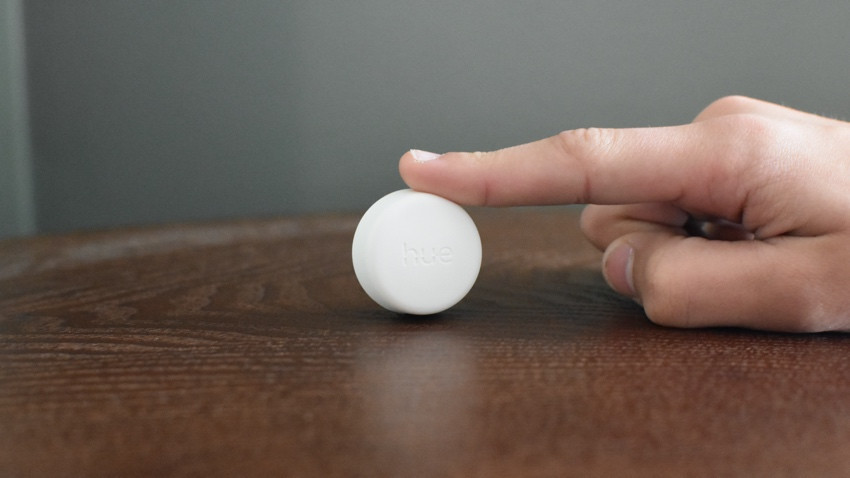
Best for Philips Hue: Philips Hue Smart Button
Buy now: Amazon | $19.99 / £17.99
Philips Hue’s Smart Button is the latest addition to Signify’s ever growing range of accessories. Stick it anywhere to control the lights in a room, area, or the whole house, and watch as it smartly adjusts them based on the time of day.
At less than $20, the Smart Button is the least expensive option from Signify for controlling your Hue lights outside of voice control or the app. The button comes pre-programed to turn the selected lights on at appropriate brightness/lighting scene based on time of day, with 5 time slots.
All of this is customizable, but nicely it just works right out of the box, with no programming or scene creating needed to get you going.
It’s not just Hue controls though – you can sync the button to your HomeKit setup, where it can work as a smart button to control any HomeKit connected device. The best use case for HomeKit is to activate a HomeKit Scene, but there are better smart button options out there if that’s something you’re looking for, such as the Eve button we have listed in this guide.
While it doesn’t play well with other light bulbs, requires the Hue bridge and has only limited control when paired to HomeKit, it’s a great addition for anyone invested in the Hue ecosystem looking for a simple, inexpensive way to control lights in a room.
Also, as of early 2023, Hue smart buttons are now able to act as triggers within an Alexa smart home system. You can configure them to kick start an Alexa Routine within the Alexa app, just like the Flic 2 button.
Also, like the Flic Twist, there is the option to go bigger with the Hue Tap Dial but you’re venturing into smart switch territory there, rather than a smart button.
What we love
- Hue native
- Slick design
- Well-priced
What we don’t love
- HomeKit limited
- Needs Hue Bridge
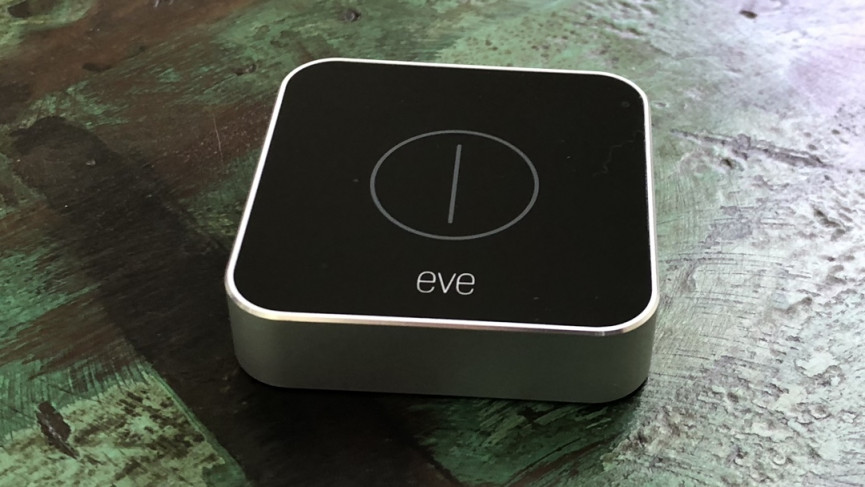
Best smart button for HomeKit: Eve Button
Buy now: Amazon | $49 / £45
Unlike Flic’s and Logitech’s smart buttons, the Eve Button doesn’t let you specify individual smart tech devices, or add multiple gadgets to a tap control; it relies on HomeKit to do the heavy lifting. Living within the Eve app, which is essentially Apple’s Home App in different clothes (you can actually do all of the configuration within the Home app, in fact), your single, double or long press options are reserved to start HomeKit scenes – and nothing else.
Now, while that does sound a bit restrictive compared to its rivals, if you’re living in a smart home controlled by Apple’s ecosystem then it’s actually a great setup. Sure, if you want to just turn a single smart light on or off, it’s a bit of a faff to set up a Home Scene for that basic control but, for more advanced chains of events, it certainly makes sense.
If you have a dedicated Apple HomeKit hub – i.e. an iPad, HomePod or Apple TV – then the Eve Button will work faultlessly in your house without issues. However, if you’re only powering your smart home using the iOS Home app on your iPhone, you’ll need that phone located nearby for things to work.
Design-wise the Eve is the bulkiest beast of the bunch, although the anodized aluminum finish does look more premium than the Pop and Flic’s plastic build. As it’s only Bluetooth LE powering the show, battery life is as long as the coin battery lasts (i.e. a long time) so you won’t need to bother charging it.
What we love
- HomeKit compatibility
- Flexible uses
- Long battery life
What we don’t love
- HomeKit restrictions
- Slightly involved setup
- Slightly bulky

Best for Alexa: Amazon Echo Button
Buy now: Amazon | $20 / £20 for 2
Sure, they started life as a gimmicky toy that allowed Echo users to play head-to-head, fastest-finger-first style quiz games and the like, but the Echo Buttons have since evolved into one of the simplest, yet most comprehensive smart buttons available… as long as you’re tied into Alexa’s ecosystem.
The Bluetooth-packing Echo Buttons, which are powered by a couple of AAA batteries and come in pairs for less than $20, are capable of just a couple of things: lighting up and changing colors thanks to the LEDs under that milky white dome and talking to a paired Echo smart speaker.
Amazon has opened up the platform to allow Echo Buttons to kick start routines and, hallelujah, the gimmicky Echo Button is now a smart button capable of controlling any devices that work with Alexa. You can only associate a button press with just one routine, but the steps of that routine are only bound by your own imagination and, of course, the actions that Amazon’s smart assistant is capable of.
For example, we’ve got one Echo Button set up by the back door – paired to a Dot in the kitchen – that, when pressed, opens our garden office’s Somfy blinds, turns on all of the smart sockets in the office, plays BBC Radio 6 Music on our Sonos speaker and turns on our desk light. Another button does all of this in reverse.
The handy ‘wait’ function of Alexa routines also means it turns everything off but waits 2 minutes before shutting the blinds, thus giving me time to escape. Oh, and it turns our robo-vacuum on too, to pick up all the crumbs from all the biscuits we’ve eaten while putting off doing some work.
Echo Buttons have actually been discontinued so you’ll have to do some online digging to grab hold of some.
What we love
- Alexa-native
- Fun game options
- Well-priced
What we don’t love
- Alexa-exclusive
- Slightly gimmicky design
- Not widely available any longer
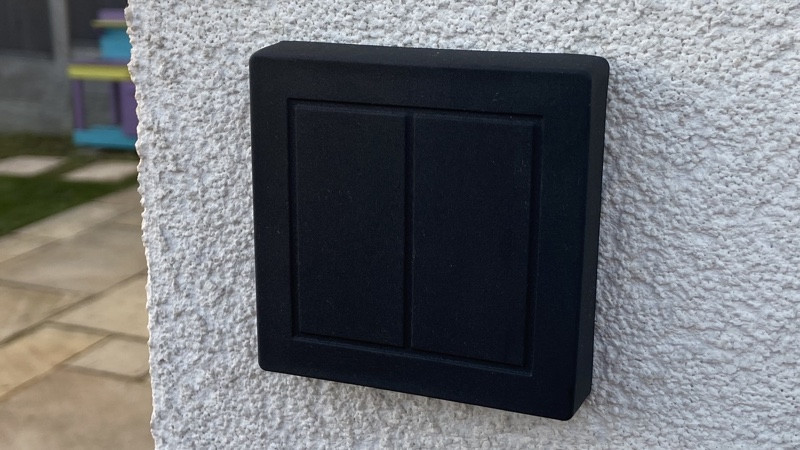
Best for the garden: Senic Friends of Hue Outdoor Switch
Buy now: Amazon | $79 / £69
Senic’s Outdoor Switch is the first Friends of Hue smart switch created for exterior use; but it’s not technically a smart light switch – it’s much more of a smart button.
There’s no need to hook it up to wiring or use screws, there are sticky pads in the box and I’ve had mine stuck a rendered wall for weeks now and it has stayed in place with no issues.
You can, if you want a bit more reassurance, take off the the rear cover plate and screw it securely to the wall. The Switch then pops over this base.
There’s no battery; the Senich is powered by EnOcean energy harvesting technology – the motion of the button being pressed (and rebounding) keeps the power topped-up.
To setup you just use the Hue app and add the Senic Outdoor Switch as an accessory. The four button setup offers a basic, yet effective, control method for your Hue bulbs. When setting up in the Hue app, you simply choose what you want to happen when each button is pressed, or held.
Therefore there are 8 inputs in total but you can extend this to 12 using third party Hue apps such as iConnectHue, which adds a double-tap into the equation.
The Outdoor Switch is also HomeKit compatible and this open up a world of extra controls such as smart speakers, heating and more.
Essentially, you can can program the Senic to do almost anything in your HomeKit home, in terms of controls, automations and scenes, although – unlike a Hue setup – you are limited to just four buttons; there’s no holding method within HomeKit usage.
What we love
- Super simple installation
- Weatherproof
- Great for Hue
- No need for a battery
- Extra HomeKit smarts
What we don’t love
- Needs a Hue Bridge
- HomeKit controls is just 4 buttons





